Hawk Moth Caterpillar
Many hawk moth caterpillars eat toxins from plants, but don’t sequester them the way milkweed butterflies do. Most toxins are excreted.
Advertisement
Hawk Moth Caterpillar Scientific Classification
Read our Complete Guide to Classification of Animals.
Hawk Moth Caterpillar Conservation Status
Hawk Moth Caterpillar Locations

Hawk Moth Caterpillar Facts
- Group Behavior
- Solitary
- Fun Fact
- Many hawk moth caterpillars eat toxins from plants, but don’t sequester them the way milkweed butterflies do. Most toxins are excreted.
- Estimated Population Size
- Millions, conservation status depends on the species.
- Biggest Threat
- Habitat loss, climate change, overuse of pesticides
- Most Distinctive Feature
- Their size and the “horn” at the end of the body of many species.
- Other Name(s)
- Hornworms
- Gestation Period
- Three to 21 days
- Litter Size
- 50 to 2000
- Habitat
- Mostly in the tropics but can be found nearly everywhere save the polar regions. They are found in gardens, the edges of forests, woods, fields, bottomlands, cities and suburbs, savannas.
- Predators
- Braconid and parasitic wasps and other predaceous insects, birds, lizards, snakes, frogs, toads, spiders.
- Diet
- Herbivore
- Favorite Food
- Leaves of many types of plants
- Type
- Insect
- Common Name
- Insect
- Location
- Europe, Asia, Africa, North America, South America, Central America, Australia
- Group
- Solitary, though there can be a lot of caterpillars on one plant
Hawk Moth Caterpillar Physical Characteristics
- Color
- Brown
- Green
- Lifespan
- About five months, tops
- Weight
- 3 to 12 grams
- Length
- Up to 4 inches
- Age of Sexual Maturity
- After pupation
View all of the Hawk Moth Caterpillar images!
“One of the largest caterpillars”
Besides being one of the largest caterpillars, hawk moth caterpillars are among the prettiest and come in shades of green or greenish-blue. Unfortunately, a caterpillar that’s supposed to grow to as much as 4 inches before it pupates needs a great deal of provender. There are legions of gardeners who go out to pick their tomatoes in the morning to find the plants stripped bare by the tomato hornworm, one of the most notorious of the hawk moth caterpillars. On the other hand, the nimble hawk moth is a major pollinator of plants both needful and beautiful.
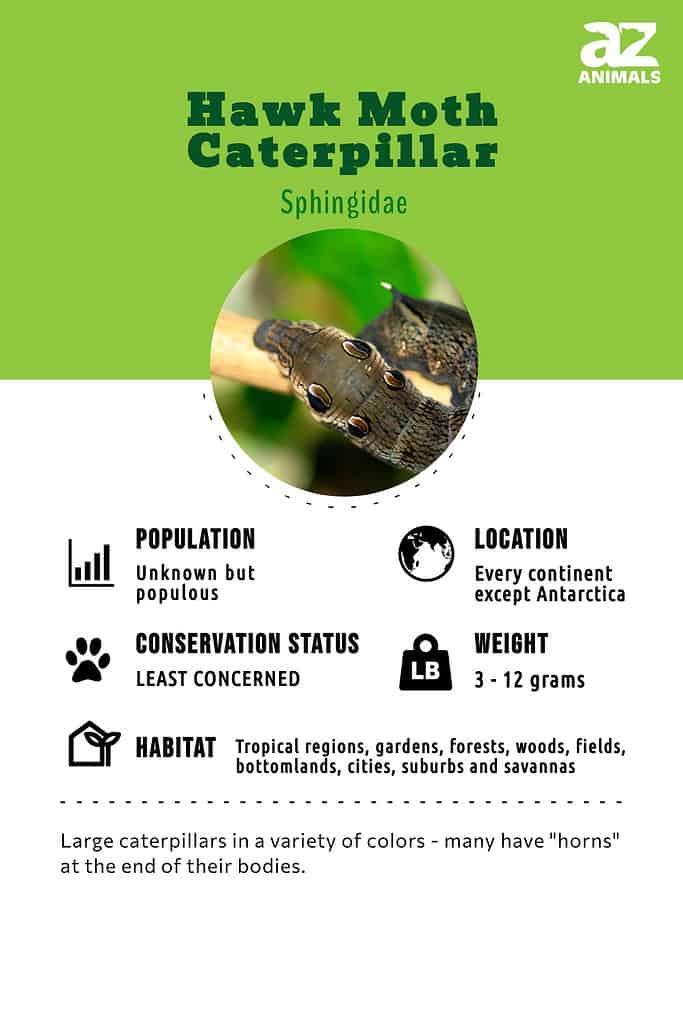
Top Facts About the Hawk Moth Caterpillar
- Some hawk moth caterpillars nip at would-be threats while others like the Abbott’s and Walnut Sphinx caterpillars hiss, squeak, and whistle.
- In warmer climates, some hawk moths have two or more generations of caterpillars a year.
- Some hawk moth caterpillars overwinter in the earth as pupae.
- The African death’s-head hawk moth was the rather creepy moth seen in the movie Silence of the Lambs, among other movies. Its scientific name Acherontia atropos comes from Acheron, a Greek river thought to be the way to the underworld, and Atropos, one of the three fates who clipped the thread of a person’s life.

The Hawk Moth Caterpillar usually has a horn at the back, though this horn is not at all hard but fleshy.
©Chekaramit/Shutterstock.com
Scientific Name
Hawk moth caterpillars belong to the Sphingidae family of moths. The family gets its name because the caterpillar raises its front legs and head when it’s at rest and so resembles the Great Sphinx of Giza. The family has three subfamilies, about 200 genera, and 1450 species. One of the three subfamilies is Macroglossinae, named for its members’ very long, probing tongues.
Species
There are 1,450 species of hawk moth including:

The hummingbird hawk-moth hovers like a hummingbird.
©aaltair/Shutterstock.com
- Hummingbird hawk-moth or white-lined sphinx moths – hover in midair while they feed making them resemble hummingbirds.
- Elephant hawk-moth – the caterpillar of this moth feeds on wild grape leaves.
- Oleander hawk-moth – the caterpillar of this moth eats oleander leaves.
- White-lined sphinx – hovers while feeding and is also mistaken for hummingbirds.
- Lime hawk-moth – these moths fly at dusk and rest on tree trunks.
- Poplar hawk-moth – these caterpillars eat toxins from plants.
- African death’s head hawk-moth – this moth migrates and got its name from its resemblance to a human face.
- Convolvulus hawk-moth – this moth has an extra-long proboscis that allows it to feed from tubular flowers.
- Nessus sphinx hawk-moth – this caterpillar makes hissing and clicking noises by moving air back and forth past a constriction in its gut.
- Eyed hawk-moth – this moth doesn’t feed as an adult but is attracted to light.
Evolution
Butterflies and moths are thought to have coevolved with flowering plants and echolocating bats. The most recent common ancestor of all extant Lepidoptera dates to the late Carboniferous period, approximately 300 million years ago. The nectar-feeding proboscis appeared around 240 million years ago in the Middle Triassic period – along with the diversification period of flowering plants.
Appearance & Behavior
Hawk moth caterpillars are large, with cylindrical bodies. They usually have a horn at the back, though this horn is not at all hard but fleshy. Other caterpillars may have a hardened button or an eyespot in the same area. For example, Abbott’s sphinx has what looks like a reptile’s eye where the horn is on other sphinx caterpillars. The caterpillar’s back legs, which are formally called anal prolegs, are flattened so they can hold on tightly to the plant as the caterpillar feeds. Hawk moth caterpillars are often wonderful shades of green with diagonal white stripes, red spots, and white granules that look like tiny pearls. Some hawk moth caterpillars turn brown as they mature.
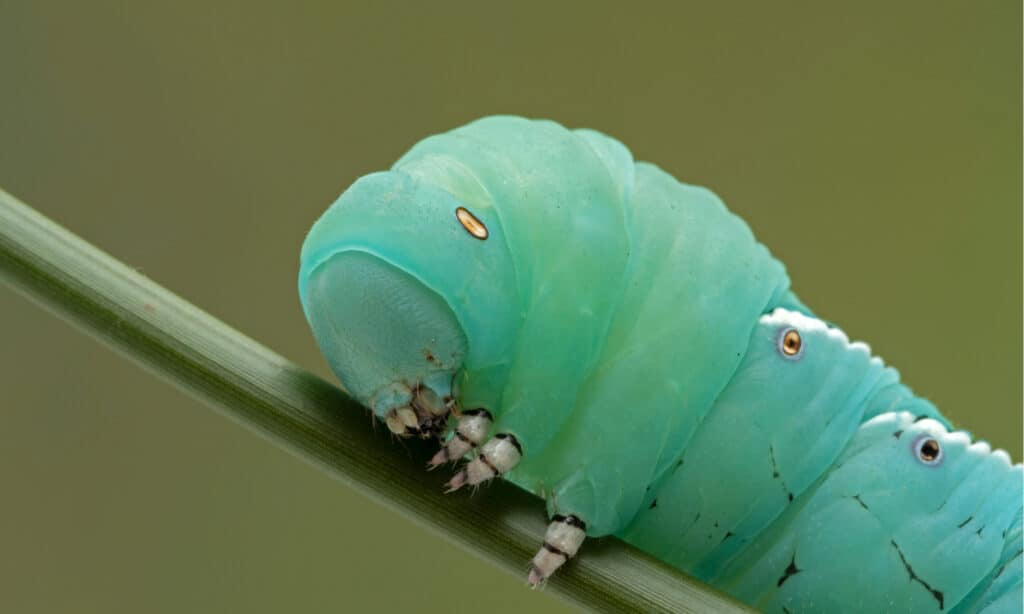
Hawk moth caterpillars simply eat all that they can for a month until they pupate.
©Ernie Cooper/Shutterstock.com
Much of the behavior of hawk moth caterpillars is simple. They eat, and they eat all manner of plants. When these caterpillars first hatch they start eating in the middle of the leaf where their egg was laid, which leaves holes that alert a gardener to a problem. Their fecal pellets also give away the caterpillar’s whereabouts because they are unusually large and grooved.
Hawk moth caterpillars do not like to be handled, and when you try to pick one up it will thrash around, vomit, try to nip at you, or may even squeak or hiss.
Eating as voraciously as they do helps the caterpillar grow rapidly. By the time it is mature, a tomato hornworm has grown 10,000 times the size it was when it hatched out of its egg 21 days before. Hawk moth caterpillars generally molt their skin four times before they reach their full size. The form of the caterpillar after it hatches or molts is called an instar, and lepidopterists can tell which instar a caterpillar has arrived at by measuring its size and sometimes its appearance.
After they have eaten and grown to the right size, some hawk moth caterpillars drop to the ground and burrow in where they pupate. Others spin a cocoon attached to the trunk or main stem of their food plant. Some hawk moth caterpillars spend the winter as pupas and don’t emerge until the next spring.
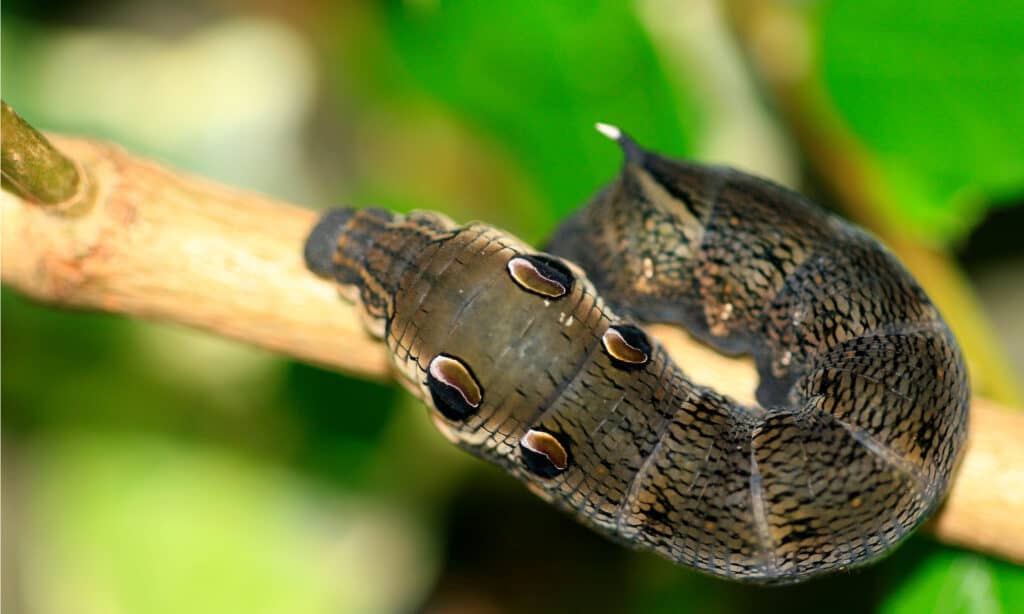
Hawk moth caterpillars prefer warm climates and have formed relationships with flowers that they pollinate.
©Eileen Kumpf/Shutterstock.com
Habitat
Hawk moth caterpillars live in a variety of habitats, but they predominate in warmer climates. There are tropical flowers that are dependent on the hawk moth adults to pollinate them. This can be seen in the relationship between the Madagascar Star Orchid and the hawk moth Xanthopan morgani, whose tongue is just long enough to reach into the long nectar spurs of the flower.
Besides tropical forests, hawk moth caterpillars can be found in gardens, fields, meadows, waste places, urban parks, woodlands, and the edges of woodlands, pine barrens, and wet meadows. They can be found in fencerows, along watercourses, and in hammocks and orchards. They are, in a word, found anywhere there is a good supply of plant food.
Diet
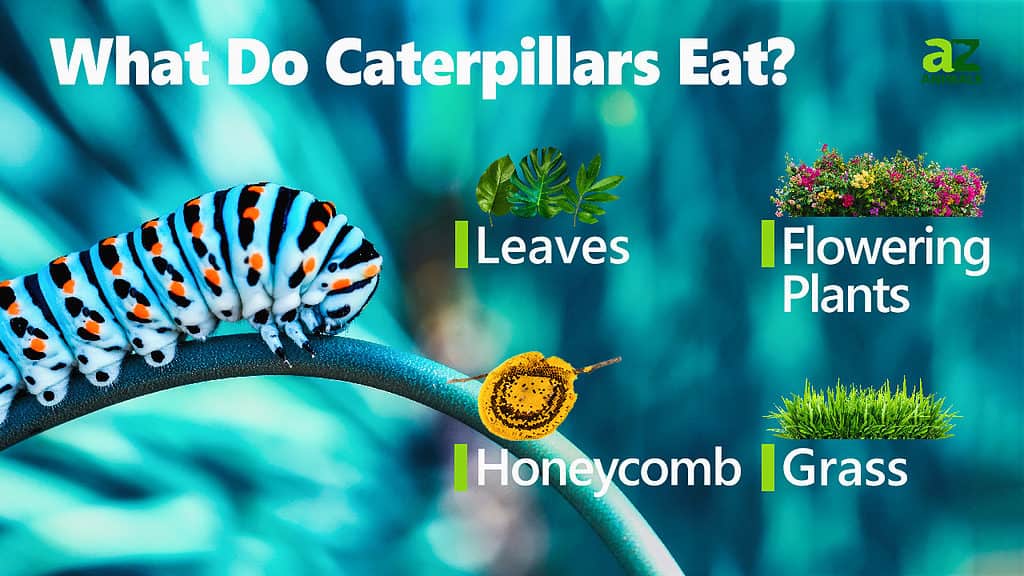
One of the reasons for the success of hawk moths is that their caterpillars seem to be able to eat any kind of plant, even if the plant is toxic. Tomato hornworms munch on the leaves of tomatoes and other nightshades, which are toxic. The letter sphinx eats Virginia creeper, which is full of raphides. The giant sphinx likes pond apples while the streaked sphinx goes for Brazilian peppers. The great ash sphinx prefers ash trees and olive trees and their relatives, while the snowberry clearwing likes honeysuckle, snowberry, and dogbane.
Predators & Threats
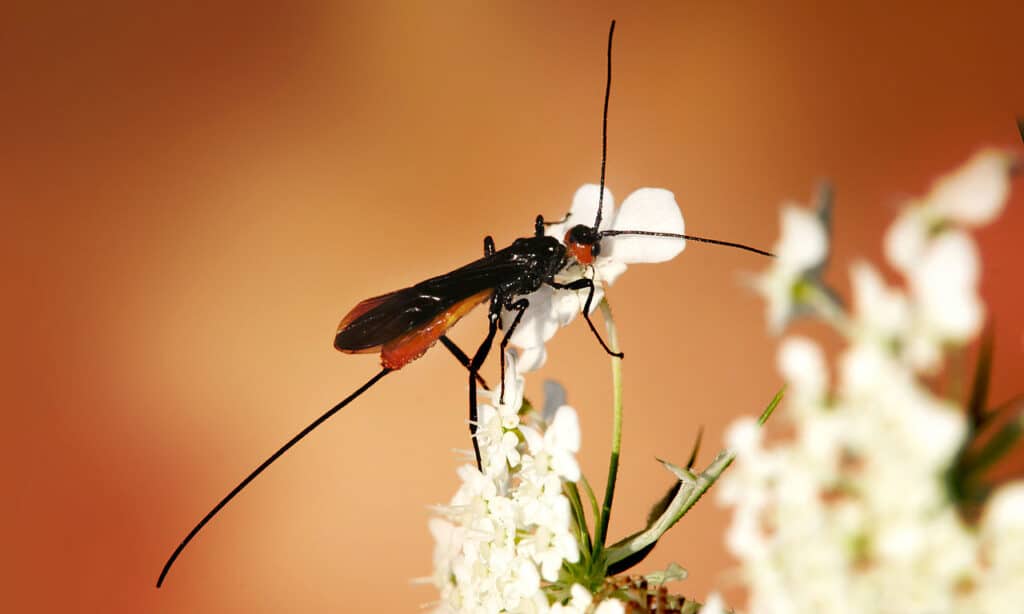
Braconid wasps lay their eggs inside hawk moth caterpillars for their young to feed upon.
©Richard Bartz, Munich aka Makro Freak / CC BY-SA 2.5 – Original / License
Hawk moth caterpillars have smooth, plump bodies that lack poisonous spines or bristles and are amazingly nutritious. Therefore they are on the menu of a great many animals. This is true even if they eat toxic plants, for most hawk moth caterpillars don’t keep the toxins in their bodies but excrete most of them. Hawk moth caterpillar predators include many types of birds, reptiles, spiders, bats, frogs, and toads. Predatory insects such as ladybugs and their own larvae eat the caterpillars when they hatch and are still tiny. Some types of hornworms are even sold as food for pet reptiles.
One of the ghastliest predators is the braconid wasp, which doesn’t eat the caterpillar herself but uses it as a food source for her babies. She deposits many eggs inside the caterpillar, and when the eggs hatch the larvae eat the caterpillar’s blood while sparing its vital organs. Eventually, they tunnel up through the caterpillar’s flesh and spin cocoons on its body. This kills the caterpillar.
Other threats to hawk moth caterpillars are climate change, habitat destruction, and the overuse of pesticides. Some of these caterpillars are pests on plants that are valuable to humans, but the adult moths also pollinate these plants.
Reproduction, Babies, and Lifespan
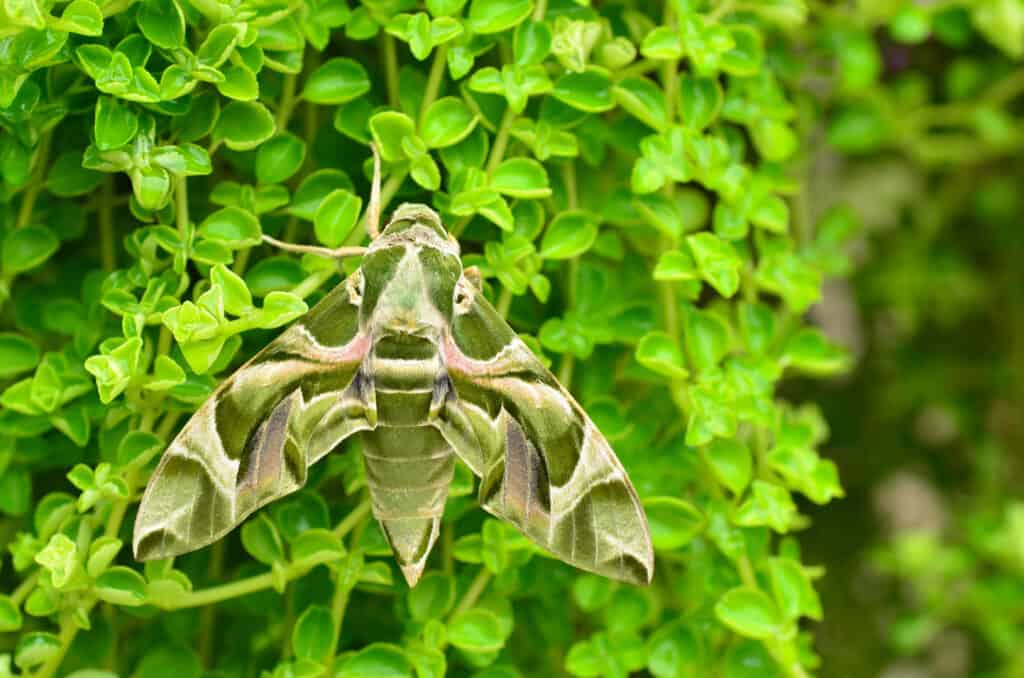
After eating for about a month, the hawk moth caterpillar pupates and becomes a moth.
©hwongcc/Shutterstock.com
The hawk moth caterpillar doesn’t reproduce but is itself the larva of the hawk moth. It hatches out of a large, smooth round egg that its mother laid on the underside of a leaf of a host plant. The hatchling is tiny compared to what it will become when it is ready to pupate.
The caterpillar feeds for about a month, and when it’s grown it stops eating and pupates. If the caterpillar was born in the spring, it will emerge as a moth sometime in the summer. If it was born later in the summer, it might remain as a pupa during the winter and emerge as a moth the next spring. An adult hawk moth only lives a few weeks.
Population

Some species of sphinx moth are endangered and near threatened.
©Sassafras56/Shutterstock.com
Though there’s some concern that the population of hawk moths, and thus hawk moth caterpillars are declining in the northeastern United States, there are still over 1400 species of hawk moths around the world, and the conservation status of many has not been classified. However, hawk moths such as Blackburn’s sphinx moth and the Kern Primrose Sphinx are endangered and near threatened respectively.
View all 104 animals that start with HHawk Moth Caterpillar FAQs (Frequently Asked Questions)
Is the Hawk Moth Caterpillar a herbivore, omnivore, or carnivore?
The hawk moth caterpillar is an herbivore. Indeed, there seem to be few plants that are off-limits to these caterpillars. Because of this, some hawk moth caterpillars are pests on crops such as tomatoes, potatoes, tobacco, and even catalpa trees in the case of the catalpa sphinx.
Does Hawk Moth Caterpillar Hibernate?
Hawk moth caterpillars don’t hibernate, but if they’re lucky and live long enough, they pupate. This means during their last molt their exoskeleton splits to reveal something like a brown seed pod. The pod doesn’t move very much and does not eat, but within it, the caterpillar’s old body is destroyed, and the new body of the moth is built. If the pupa is to overwinter, it may go into dormancy or diapause where the transformation is halted for a while until the weather warms up.
Thank you for reading! Have some feedback for us? Contact the AZ Animals editorial team.
Sources
- Missouri Department of Conservation / Accessed May 4, 2022
- Project Noah / Accessed May 4, 2022
- Breeding Butterflies / Accessed May 4, 2022
- Wikipedia / Accessed May 4, 2022
- U.S. Forest Service / Accessed May 4, 2022
- University of Minnesota Extension / Accessed May 4, 2022
- Australian Museum / Accessed May 4, 2022
- National Library of Medicine / Accessed May 4, 2022
- Wildlife Journal Junior / Accessed May 4, 2022

















